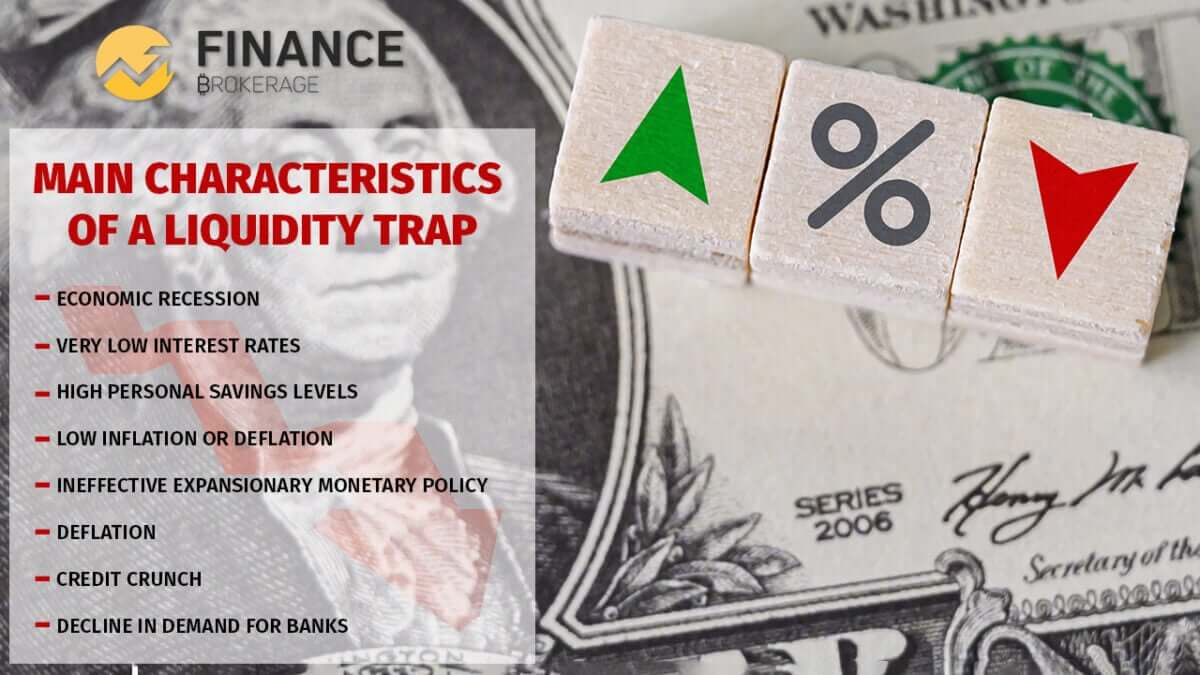
What is a liquidity trap? Definition and examples
In macroeconomics, the interplay between money supply, interest rates, and aggregate demand is pivotal in shaping a nation’s economic landscape. The enigmatic phenomenon known as a liquidity trap has long perplexed economists and policymakers.
A liquidity trap is when the usual levers of monetary policy lose efficacy. Instead, interest rates remain stubbornly low, despite an expansionary money supply.
To unravel the intricacies of this conundrum, one must delve into the economic history, from the Great Depression of the United States to the aftershocks of a financial crisis.
This article aims to shed light on the concept of a liquidity trap. Therefore, we elucidate its underlying principles, examining the infinitely elastic demand for money. We will also demonstrate how this perplexing scenario can significantly affect interest rates.
Understanding liquidity trap
It was John Maynard Keynes who mentioned the notion of a liquidity trap. This concept is mentioned when the monetary policy of a central bank is no longer capable of stimulating the economy through very low or close to zero short-term interest rates.
In the case of a liquidity trap, the main economic agents no longer find any reason to hold bonds. It’s because they display a rate close to or equal to zero. They then prefer to hold cash.
From then on, expansionary monetary policy no longer plays its role. The effect of money creation by the central bank is erased by hoarding. The currency is not invested in the real economy.
Commercial banks prefer to accumulate liquidity with central banks rather than grant loans at interest rates considered too low. Households, for their part, prefer to keep money in their savings accounts rather than invest or consume.
The central bank is, therefore, no longer able to stimulate the economy by lowering interest rates of interest. Indeed, in general, a drop in interest rates has the effect of increasing investments, leading to a drop in savings and, ultimately, causing an increase in growth.
What causes a liquidity trap?
Liquidity traps is a situation that occurs primarily due to a combination of economic factors and the behaviour of market participants.
- Interest Rates at or Near Zero Bound
A liquidity trap typically begins when short-term interest rates approach or reach the zero lower bound (ZLB). At this point, central banks have limited room to reduce interest rates further through conventional monetary policy tools.
- Deflation
When consumers and businesses expect prices to fall in the future (deflation), they may delay spending and investment. This expectation of deflation can lead to a situation where people hold onto money rather than invest it in bonds or other assets. This hoarding of cash reduces the velocity of money in the economy.
- Lack of Investment Demand
In a liquidity trap, businesses may be hesitant to invest in new projects or expand their operations due to weak consumer demand and economic uncertainty. This lack of investment demand can further reduce economic activity.
- Preference for Liquidity
During periods of economic uncertainty, individuals and private sector businesses may have a strong preference for holding liquid assets. They prioritize safety and liquidity over higher-yielding but riskier assets.
- Market Psychology
Market participants’ expectations and psychology can play a significant role in liquidity traps. If investors believe that interest rates will remain low for an extended period, they may adjust their behaviour accordingly, reinforcing the trap.
- Excess Saving
There may be a surplus of savings in the economy, which isn’t being channeled into productive investments. These excess savings can result from factors like a high propensity to save, income inequality, or a lack of attractive investment opportunities.
- Central Bank Policy
Sometimes, central banks may inadvertently contribute to a liquidity trap by signaling a lack of willingness to pursue more aggressive monetary policy measures, which can reinforce expectations of low-interest rates.
The main characteristics of a liquidity trap
A liquidity trap occurs when consumers, investors, and businesses opt to hoard their cash, making the entire economy resistant to policy actions intended to stimulate economic activity.
The following are the main characteristics of a liquidity trap:
- Economic recession
- Very low interest rates (at or close to 0%)
- High personal savings levels
- Low inflation or deflation
- Ineffective expansionary monetary policy
- Deflation
- Credit crunch
- Decline in demand for banks
Signs of a Liquidity Trap
A sign of a liquidity trap can be identified by the presence of low interest rates. These low-interest rates have a significant impact on the actions of bondholders, especially when coupled with concerns about the current financial state of the country.
Consequently, the outcome is the sale of bonds at a level that is detrimental to the overall economy.
At the same time, consumers tend to opt for low-risk savings accounts rather than investing their money elsewhere. When a central bank increases the money supply, it injects additional funds into the economy in the hope that some of it will be directed towards higher-yielding assets such as bonds.
However, in a liquidity trap scenario, this money is simply stored away in cash accounts.
When does an economy fall into the liquidity trap?
In general, we see this type of phenomenon after a shock in the economy. Often, it is the fall in the stock markets that is the cause of this shock. This causes interest rates to fall and the desire to save (fear of the future) to increase.
People either expect deflation or a serious event like a war, for example. Below a certain interest rate, an accommodative monetary policy no longer seems to work. People expect rates to rise and no longer want to invest in bonds.
The liquidity trap! Behind this barbaric name hides an economic concept which is nevertheless not impossible to understand. In theory, when the money supply increases, the interest rate decreases, which makes it possible to increase investment and, therefore, revive growth (by increasing aggregate demand).
The Central Bank of a country can influence the interest rate by increasing the supply of money, that is to say, to simplify, by printing money. Indeed, in the money market, the equilibrium interest rate is the intersection between the demand for money and the supply of money.
The demand for money is negatively related to the interest rate. It’s simply because when the interest rate is low, individuals and businesses do not want to invest their money by purchasing treasury bonds and prefer to keep cash on them. Conversely, when rates are high, they buy Treasury bonds, thus reducing the demand for money.
What is an example of a liquidity trap?
It is no coincidence that the liquidity trap appeared with the subprime affair in 2007. It grew with the sovereign debt affair. In fact, it is the apparent manifestation of the systemic crisis into which the entire banking system is irremediably sinking.
On the interbank markets, in the United States, in Europe and in most financial centres (2007-2008), lending banks no longer want to accept from their fellow borrowers the “subprime” securities that they accepted just the day before as collateral.
This was the first systemic shock followed two or three years later (2010 – 2011) by a second shock amplifying the previous one, produced by sovereign securities depreciated by the rating agencies.
Is a Liquidity Trap the Same as a Recession?
A liquidity trap has the potential to exacerbate a recession. In this scenario, individuals opt to save their money instead of actively spending or making investments.
Despite interest rates being at historically low levels, these rates do not stimulate increased spending. The conventional strategy of central banks, which involves further lowering interest rates, becomes ineffective as rates are already hovering around zero.
This situation can trigger a downward spiral into a recession. Reduced demand for goods and services prompts producers to scale back production and employment.
Why Do Individuals Choose to Hold Cash During a Liquidity Trap?
There are various factors that lead people to retain cash during a liquidity trap. The first is a lack of confidence in the ability to generate a higher return on investments. Then come concerns about the potential onset of deflation (a period of falling prices).
And finally, there are cautious approaches stemming from apprehensions about impending economic challenges, both on a personal and macroeconomic scale.
In the context of these uncertainties, individuals may opt to preserve their cash reserves. They do it either for future investment opportunities or to await more favourable pricing conditions for their investments or expenditures.
These apprehensions, when shared by a significant portion of the population, can collectively shape economic reality.
Is the United States Currently in a Liquidity Trap?
As of early 2023, the U.S. economy is grappling with inflationary pressures and increasing interest rates. While these developments do present challenges, they do not align with the conditions typically associated with a liquidity trap.
A liquidity trap, by definition, materializes during periods characterized by exceptionally low interest rates. In this scenario, the central bank endeavours to push lending rates to enticingly low levels. Yet consumers, businesses, and investors remain unresponsive, opting to hold their funds in cash instead.
Source: Lhuissier, Stéphane, Benoit Mojon, and Juan Rubio-Ramírez. “Does the Liquidity Trap Exist?” BIS Working Paper, no. 855, 2020.
Has the United States Ever Encountered a Liquidity Trap?
Perhaps, although reaching a consensus among economists regarding the existence of a liquidity trap can be challenging, some economists contend that the U.S. briefly entered a liquidity trap at the onset of the COVID-19 pandemic.
The stock market experienced a sharp decline, and concerns mounted about the economy’s ability to withstand the economic shock. Notably, a sudden surge in the Federal Reserve’s M1 measure in mid-2020. It gauged the total amount of cash in circulation, contributing to this perspective.
How to escape the liquidity trap?
What are the solutions for curing the liquidity trap? Curing a liquidity trap is a challenging economic situation. Nominal interest rates are near zero, and conventional monetary policy tools are ineffective. It requires unconventional policy measures and strategies. Here are some potential solutions:
Central banks can implement quantitative easing programs. In QE, the central bank purchases financial assets (typically government bonds) from the market to inject money into the economy. This boosts the money supply, lowers long-term interest rates, and encourages lending and spending.
Some central banks have experimented with negative interest rates on reserves held at the central bank. This encourages banks to lend rather than hold excess reserves, potentially stimulating economic activity.
Governments can employ expansionary fiscal policies, such as increasing government spending or cutting taxes, to boost aggregate demand. These policies can complement monetary efforts by injecting money directly into the economy.
Although rarely used, the concept of “helicopter money” involves direct transfers of money from the central bank to individuals or households. This can be a way to increase consumer spending and aggregate demand.
A weaker currency can make a country’s exports more attractive, potentially boosting economic activity. In a liquidity trap, currency depreciation can occur if interest rates are expected to remain low for an extended period.
Also, removing regulatory barriers to investments can enhance economic growth potential and encourage businesses to invest.



